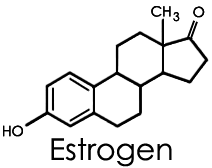 Thanks to modern medicine, we understand how the endocrine system works, says Marla Ahlgrimm. We know that the brain stimulates the production of different hormones in response to physical and emotional situations. For example, we know that menopause is triggered by a reduction in the female sex hormones estrogen and progesterone and that PMS is also controlled by hormones. But it wasn’t always that way. It wasn’t until the mid-1800s that doctors started to seriously consider that something other than God controlled the human body.
Thanks to modern medicine, we understand how the endocrine system works, says Marla Ahlgrimm. We know that the brain stimulates the production of different hormones in response to physical and emotional situations. For example, we know that menopause is triggered by a reduction in the female sex hormones estrogen and progesterone and that PMS is also controlled by hormones. But it wasn’t always that way. It wasn’t until the mid-1800s that doctors started to seriously consider that something other than God controlled the human body.
According to Marla Ahlgrimm, in 1848 Dr. Arnold Berthold performed what many consider the first scientific experiment relating to hormones. In this simple study, the good doctor castrated a pair of roosters. Soon, their bright red combs, a sign of fertility in the species, became faded and dull.
The experiments got even weirder when the same doctor castrated a second pair of roosters. But he did not stop with castration. Marla Ahlgrimm says the doctor implanted a testicle from the opposing rooster in the abdomen of each. The newly-implanted roosters retained virility. It was nearly 100 years later that testosterone was named the male hormone.
Marla Ahlgrimm says humans’ fascination with hormones has often taken strange and disturbing turns. In the early 20th century, a woman named Barbara Balaban launched a nationwide effort to collect pituitary glands from the dead with the intention of injecting its hormones into her very short son.
While much of this research seem strange to us today, Marla Ahlgrimm says it has all been instrumental in leading to awareness of health issues, such as infertility. Without our odd and eccentric ancestors, we may have never developed hormone replacement therapy or other women’s health treatments that have been instrumental in keeping females healthy for the last hundred years.













 Marla Ahlgrimm has co-authored two ground-breaking books,
Marla Ahlgrimm has co-authored two ground-breaking books,